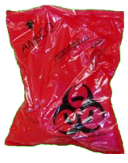Autoclave use can pose physical hazards (e.g. heat, steam and pressure) and biological hazards (e.g. improperly autoclaved infectious materials). This fact sheet provides basic guidance on the safe operation of autoclaves.

How can I protect myself?
TRAINING
The PI/Supervisor for each laboratory shall ensure personnel are provided safety training before operating an autoclave. All training must be documented and the records maintained in the lab with other safety training certificates.
At a minimum, training must cover the safety guidance provided in this fact sheet as well as the operating instructions in the user manual for the specific model of autoclave.
GENERAL AUTOCLAVE SAFETY PRACTICES
Do not autoclave items containing corrosives, solvents, volatiles or radioactive materials.
Prior to loading
- Before using the autoclave, check inside the autoclave chamber for any items left by previous users that could pose a hazard.
- Ensure that the drain strainer is clean before loading the autoclave.
- Ensure that the door gaskets have not deteriorated, but are still intact and pliable.
Loading the Autoclave
- Load the autoclave as per the manufacturer’s recommendation. DO NOT overload the autoclave.
- Individual glassware pieces should be placed in a heat resistant plastic tray on a shelf or rack, and never placed directly on the autoclave chamber bottom or floor.
- Make sure that the door of the autoclave is fully closed and latched and ensure that the correct cycle for the items being autoclaved has been selected before starting the cycle.
Opening the Autoclave
- Wear the proper PPE, including:
- Heat resistant gloves and arm sleeves
- Rubber apron– If no hot liquids are involved, a lab coat is sufficient
- Eye protection
- Faceshield (when hot liquids are handled)
- Closed-toe shoes If handling sharps (e.g. broken glass), use tongs or ensure gloves are cut-resistant.
2. Open the door slowly. Keep your head, face and hands away from the opening.
3. Allow materials inside the autoclave to cool for at least 10 minutes with the door open before unloading the autoclave. Removing contents too soon may cause heat stress and fracturing of materials, especially glass.
MONITORING
Autoclave operators shall ensure that each autoclave is monitored as follows:
Heat Sensitive Tape Monitoring – Operators shall use heat sensitive sterilization indicator tape for each load to indicate that the load has undergone an effective steam sterilization process.
Note that this tape only indicates that the proper temperature for the cycle has been reached, but does not indicate that it was heated at the proper pressure or for the appropriate length of time.
Ensure that the heat sensitive tape used does not contain a lead based indicator, as this type of tape must be collected and managed as hazardous waste.
INSPECTION AND MAINTENANCE
Manufacturer-recommended periodic inspection and preventive maintenance shall be conducted and recordkeeping shall be maintained.
Emergency Procedures
If an injury occurs during autoclave use, seek prompt medical attention.
As soon as conditions permit, report the incident to your supervisor and call the Occupational Health Center at (650) 725-5308 for necessary injury follow-up.
How do I dispose of this?
Biological Indicators
Operators who autoclave medical/ biohazardous red bag waste must do the following:
At least once a month, autoclave a biological indicator such as Bacillus stearothermophilus (sold under the name Prospore2) placed at the center of a load processed under standard operating conditions to confirm adequate sterilization.

Special Problems and Procedures
ADDITIONAL PRACTICES FOR AUTOCLAVING LIQUIDS
When running an autoclave cycle with liquids, the cycle time is longer but uses lower temperatures to minimize evaporation of the liquids. Liquid cycles also have a longer depressurization time to avoid “boil-over” of liquids.
1. To prevent bottles from shattering during pressurization and heating, the caps of containers with liquids must be loosened before loading.
2. Use only borosilicate glass (Pyrex™ or Kimax™) which can withstand the high autoclave temperatures.
3. Use a heat resistant “autoclave” tray with a solid bottom and walls to contain the contents and catch spills.
4. Liquids should be within a heat resistant plastic tray containing an inch of water, to ensure even heating.
a. Bottles of liquid should not be more than 2/3 full.
b. Keep 1-2 inches of space between bottles.
5. After unloading from the autoclave, let the liquids cool for at least a full hour before touching with ungloved hands. Be sure to let others in the area know that a heat hazard is present.
ADDITIONAL PRACTICES FOR AUTOCLAVING DRY LOADS
1. Add ¼ to ½ inch of water to the tray so that the contents will heat evenly.
2. Check plastic materials to ensure that they are compatible with being autoclaved.
a. For example, polyethylene plastics (LDPE and HDPE) cannot be autoclaved.
3. After unloading from the autoclave, let the materials cool for a minimum of 15 minutes before touching with ungloved hands.
AUTOCLAVE FAILURE
Discontinue use immediately if an autoclave is not working properly. Post a sign alerting others not to use the autoclave.
Mechanical failures need to be attended to by a trained technician. Contact the service company responsible for the maintenance of your autoclave or your department’s safety representative for further guidance.
